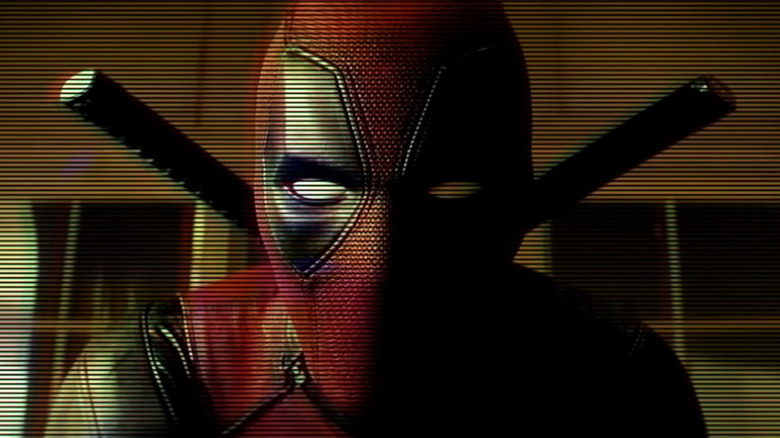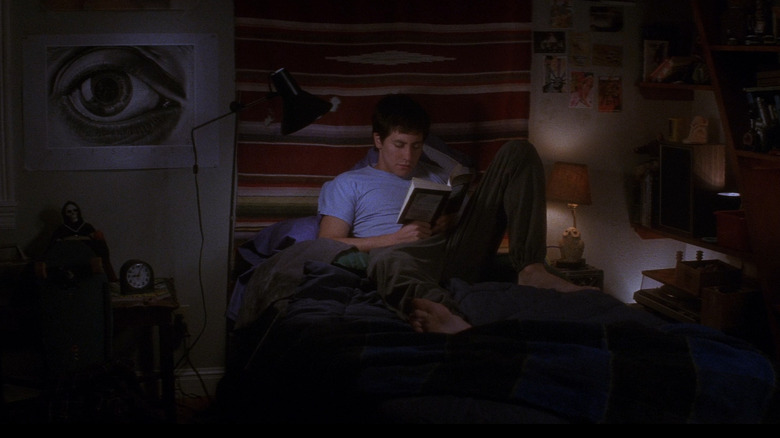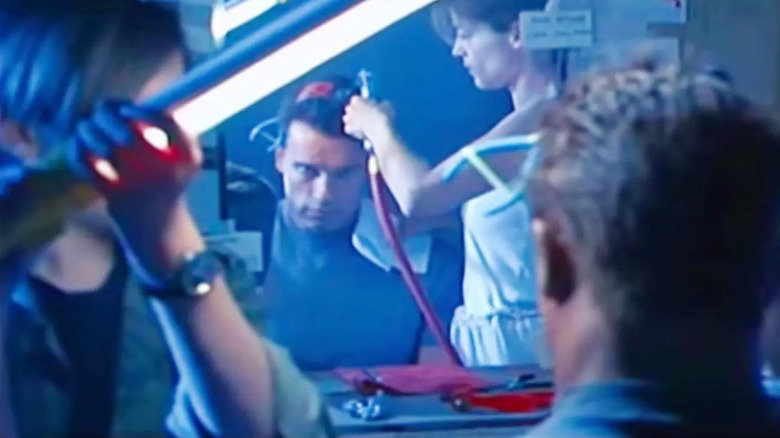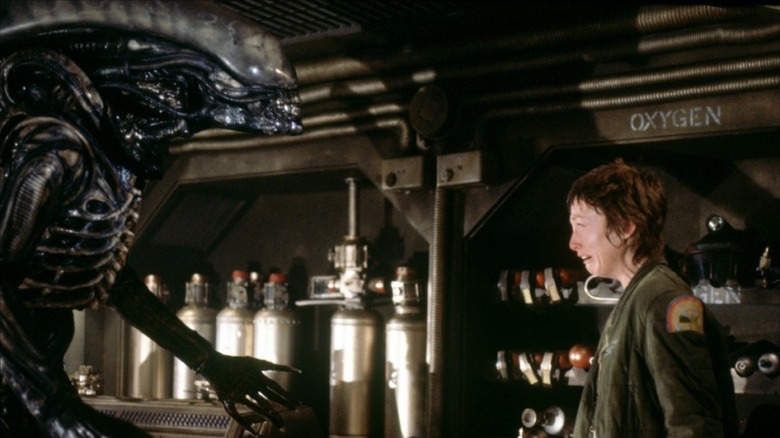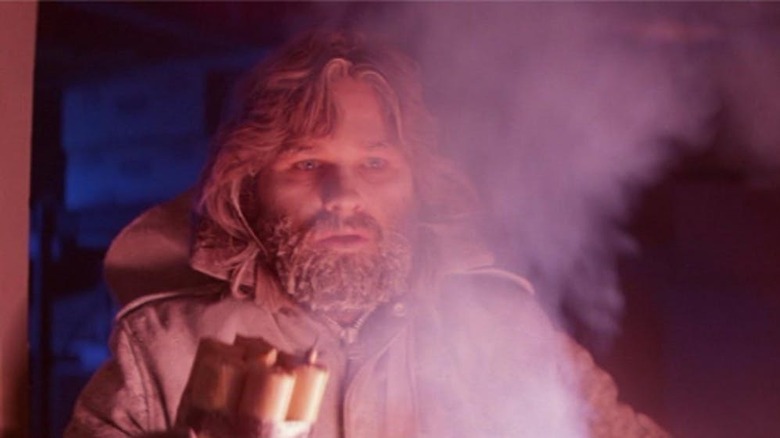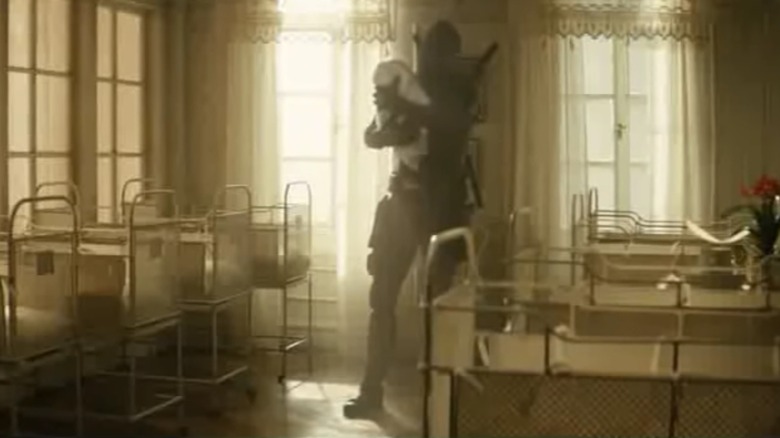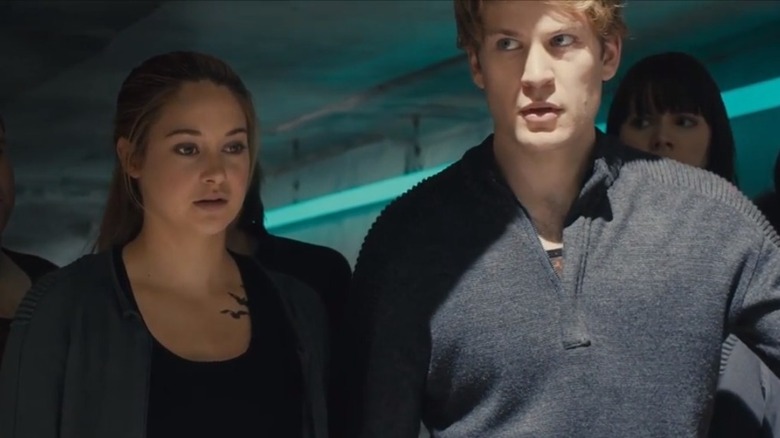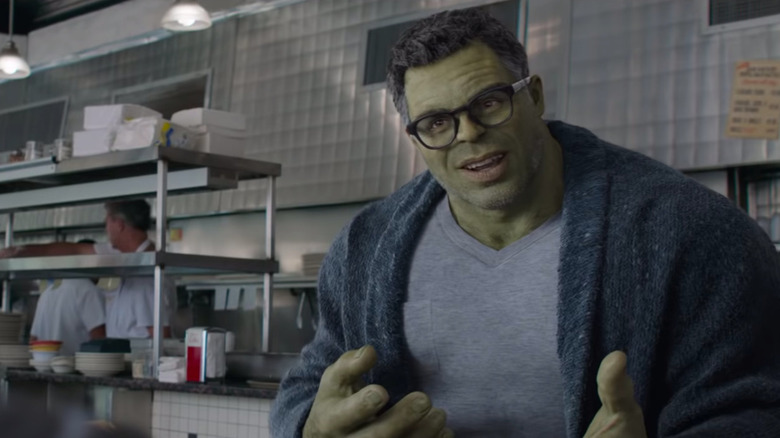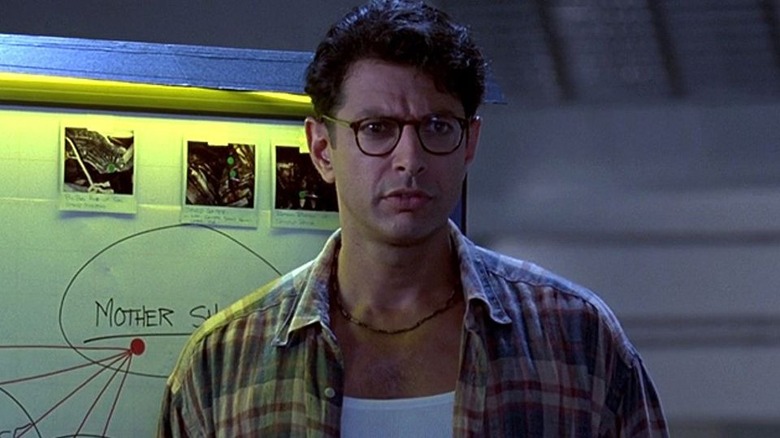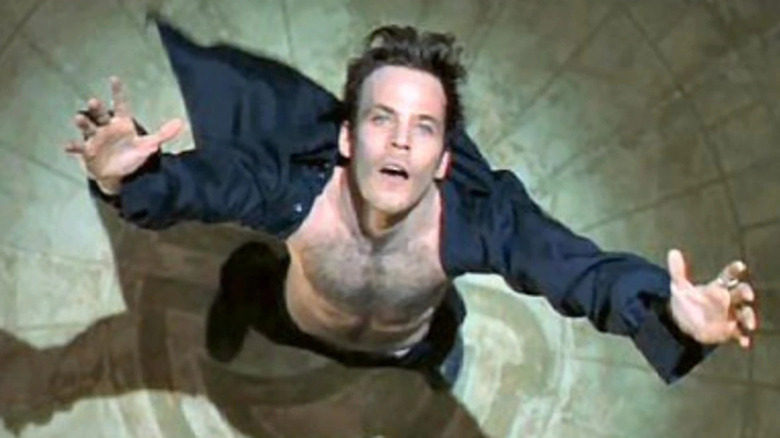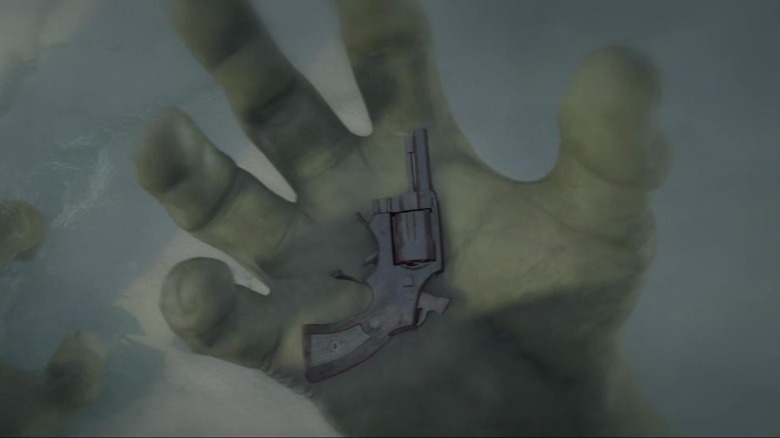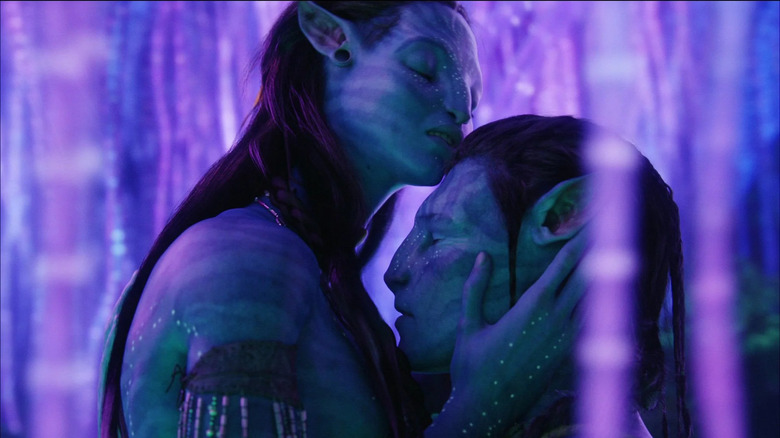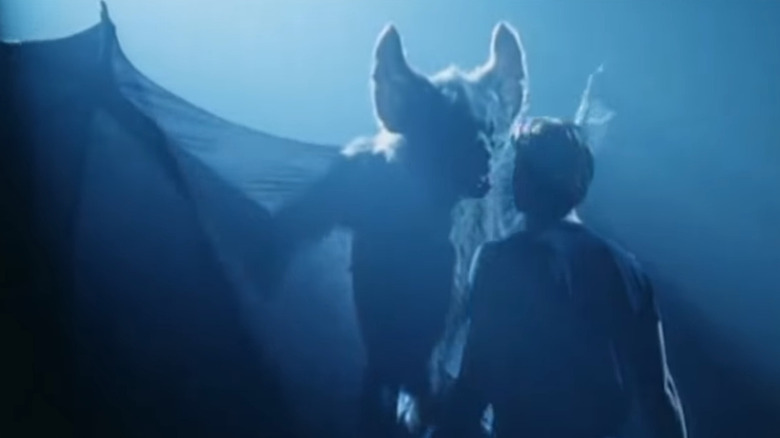Sci-Fi Movies That Were Saved By Deleting Scenes
Deleted scenes are a treasure trove for curious movie fans. It is interesting to see how key moments could have altered some of your favorite movies. Why were these scenes cut, and do they hold up on their own? There are some great moments that film fans would argue didn't deserve to be removed. A lost action sequence from the 1933 monster movie "King Kong" has become a legend in the eyes of many genre fans. However, major scenes can sometimes be removed in order to change a plot point. In 2005's "Star Wars: Episode III — Revenge of the Sith," an entire sequence was cut where General Grievous (Matthew Wood) executes the Jedi Master Shaak Ti. After the scenes were removed from the final cut, Shaak Ti's death was retconned in the "Star Wars" expanded universe. The character later appeared in the 2008 video game "Star Wars: The Force Unleashed," which reveals that she survived Order 66.
Films will occasionally have to cut scenes in order to receive a lower rating from the MPAA, as when the group initially handed an R-rating to Marvel Studios' 2012 film "The Avengers" due to the graphic death of S.H.I.E.L.D. agent Phil Coulson (Clark Gregg). In order to receive a more family-friendly PG-13 rating, Marvel edited down the sequence to make it less violent. However, sometimes scenes are removed because they are simply not working. These science fiction movies did themselves a favor by removing these baffling scenes.
Donnie Awaits His Death — Donnie Darko (2001)
Richard Kelly's 2001 time travel thriller "Donnie Darko" bewildered audiences when it was first released. The moody take on a coming-of-age story had deep metaphorical undertones, and Kelly's director's cut helped make the film a lot more comprehensible by explaining the complex mythology of time travel. These explanatory scenes were cut to keep the film's running time shorter, but there was one sequence that was removed from the original film for a completely different reason.
At the end of "Donnie Darko," Donnie (Jake Gyllenhaal) chooses to accept his own death, which ends up benefiting his community. He saves his family from perishing and exposes the child pornography stash held by the inspirational speaker Jim Cunningham (Patrick Swayze). It's a bittersweet ending. However, there was originally an extended version of the ending that included a shot of Donnie impaled in his bed, gasping his final breaths. Kelly decided to remove the scene and simply imply that Donnie had been killed. Not only is this scene a little too disturbing, but it ends the film on the wrong note. While "Donnie Darko" has a lot of scary moments, something so downbeat would have felt like a significant tonal shift. It's also an unpleasant way to end the story. Donnie's implied death in the theatrical version was already powerful enough.
The Timeline Is Obliterated — Terminator 2: Judgment Day (1991)
James Cameron spent a lot of time fleshing out the time travel elements in "The Terminator" franchise, which can get very confusing in general. It's very easy to create inadvertent plot holes that make the entire premise of the film seem implausible. As far as time travel movies go, 1991's "Terminator 2: Judgment Day" is one of the best and most coherent. Thankfully, Cameron saved the film at the last minute by removing an additional scene that would have shattered the emotional weight of the franchise.
Cameron cut a sequence from the middle of the film where Sarah and John Connor (Edward Furlong) open up the T-800's (Arnold Schwarzenegger) skull to activate a computer chip switch while also allowing him to begin learning and adopting human characteristics. If this scene remained part of "The Terminator" saga's canon, it would have implied that the only way that robots can learn to become more human is if they have their chips activated. This would have made the T-800's characterization in the 2019 sequel "Terminator: Dark Fate" completely illogical. Removing this scene also makes the story more emotionally effective. By the end of the film, the audience understands already that John has taught the T-800 to become more human. It's more powerful to simply imply the relationship that they formed; having a dull, logical answer doesn't make the film any stronger.
Lambert's Extended Death — Alien (1979)
Ridley Scott's 1979 film "Alien" isn't just one of the best science fiction films ever made, but one of the scariest. The logline of "Alien" was simply perfect: what if you made "Jaws" in space? Like all great horror filmmakers, Scott understood that to keep the audience terrified, less is more. It's scarier to imply that something horrific is happening than to show it in a graphically violent way. There are enough genuinely sickening death sequences in "Alien" that removing the extended demise of Lambert (Veronica Cartwright) was a good decision.
A deleted scene made Lambert's death far more gruesome than in the final cut. In the original version her death is already terrifying, as the audience is able to see the horror on Cartwright's face before she meets her bitter end. The extended scene feels like it was taken out of a much goofier piece of science fiction schlock, and not an elevated horror film. The Xenomorph — mostly kept in the shadows in the original film — appears in full view of the camera. Compared to other science fiction films from the 1970s, "Alien" has aged incredibly well. The deleted scene is the only moment where the visual effects and makeup work truly do not hold up. Thankfully, Scott came to his senses and decided to cut down on the brutality, resulting in a far scarier moment where the audience is left to imagine the horror that awaits Lambert.
The Alternate Ending — The Thing (1982)
John Carpenter's 1982 masterpiece "The Thing" has one of the most perfect science fiction endings of all time. After surviving the battle in the bunker, MacReady (Kurt Russell) and Childs (Keith David) sit together for an uneasy moment. Both characters suspect that one of them could be the monster. Are they both safe, or is one of them doomed to meet a gruesome fate? Carpenter leaves it ambiguous, a bold choice to end the film, and part of the reason that fans have returned to watch "The Thing" again and again. It is fun to search for clues that suggest if either character is really the monster.
However, this fascinating ending would have been completely ruined if Carpenter had decided to restore the film's original ending. In a deleted sequence, MacReady travels to another research facility and takes a blood test. The results of the test confirm that he is human, which would have caused all the suspense and paranoia that "The Thing" had established to instantly disappear. The safe, overtly happy wrap-up would have wholly contradicted Carpenter's original vision. It also would have been strange to end the film on such an optimistic note, as Carpenter has never been interested in going out of his way to please the audience. "The Thing" would have lost all of its momentum if MacReady was conveniently revealed to not be the monster.
Deadpool Kills Baby Hitler — Deadpool 2 (2018)
The "Deadpool" films have enjoyed using their dark humor to shock audiences. "Deadpool" was hardly the first R-Rated comic book movie, but the level of sexual content, language, and violence that the two films contained felt like a breath of fresh air compared to other modern superhero movies. The two "Deadpool" films have some genuinely intelligent commentary on the state of the modern film industry, but they also have a lot of off-color, dark jokes.
Yet, there's a difference between pushing the audience out of their comfort zone and just being in poor taste. A deleted scene from "Deadpool 2" was removed for being too dark, even for the "merc with a mouth." In what was intended to be a post-credit stinger, Deadpool (Ryan Reynolds) uses a time travel device to go back to 1880, where it is implied that he murdered the infant Adolf Hitler. Although the scene does not explicitly show the murder, it's still fairly uncomfortable to watch. The "Deadpool" films work because of their adolescent humor, but this scene feels like it is only there to make teenage boys laugh. Child murder isn't particularly funny, even for the "Deadpool" franchise. The time travel sequences that are in the film tie directly to the "X-Men" franchise and Reynolds' career. They are already effective enough, and it's much funnier to see Deadpool make fun of "X-Men Origins: Wolverine" and "Green Lantern" than it is to see him murder an infant.
Edward Is Stabbed Through The Eye — Divergent (2014)
In the wake of the success of "The Hunger Games" franchise, there were many dystopian young adult novels adapted into prospective film sagas. As far as "The Hunger Games" knock-offs go, the first "Divergent" film isn't half bad. The story is simple and straightforward, and Shailene Woodley delivers an empathetic performance as the central protagonist, Tris Prior. The film spends more time dealing with how the restrictive dystopian society influences the adolescent characters as they grow up than it does deconstructing the horrors of fascism.
"Divergent" isn't as violent or disturbing as "The Hunger Games," but a deleted death scene could have pushed the film in a much darker direction. Tris and her companions train to rise within the ranks of the Dauntless program. The bully Peter Hayes (Miles Teller) stabs another trainee named Eddie (Ben Lamb) through the eye so that he can improve his ranking. This would have been far too gruesome for the tone of the film. It also would've made Peter's redemption arc in the sequel, 2015's "Insurgent," feel out-of-character.
Professor Hulk Is Revealed — Avengers: Infinity War (2018)
"Avengers: Infinity War" ends with one of the most epic superhero team-ups in comic book movie history where a portion of the Avengers team unites in Wakanda to resist the army of Thanos (Josh Brolin). However, there is one member of the team that is absent from the battle, since Bruce Banner (Mark Ruffalo) has been unable to transform into the Hulk for the entire film. Audiences would have to wait until 2019's "Avengers: Endgame" to see Banner become "Professor Hulk." However, directors Anthony and Joe Russo originally intended to introduce Professor Hulk at the end of "Infinity War."
The decision to cut the moment from "Infinity War" strengthened both films. The first act of "Endgame" is very grim, as the characters are dealing with the consequences of their failure to stop Thanos from wiping out half of the life in the universe. Adding in the humorous Professor Hulk scene at the beginning gave the audience a break from the dark tone. Although the battle at the end of "Infinity War" is incredible, the final act of "Endgame" is even more epic. Saving Professor Hulk for the climax of the "Infinity Saga" was more satisfying, and "Endgame" featured more than enough awesome Hulk action to keep MCU fans happy.
The Computer Virus Is Developed — Independence Day (1996)
It's easy to poke fun at "Independence Day." You can give Roland Emmerich's 1996 science fiction action film a lot of praise, but few would defend the film as a "serious" take on the sci-fi genre. If you try to break down "Independence Day" with logic, it ultimately falls apart. This is part of the film's magic, where you're not really supposed to ask any deep questions about the plot. It's more fun to simply sit back and enjoy the spectacle.
However, a deleted scene from the film tried to give a somewhat reasonable explanation of how Captain Steven Hiller (Will Smith) and David Levinson (Jeff Goldblum) pulled off their daring final mission. David analyzes the wreckage of the alien ship in Area 51 and realizes that the aliens' mothership is vulnerable to the computer virus that he uses to lower the vessel's shields. While this was most likely included to make the conclusion seem more plausible, it relies on David coincidentally finding the code. Audiences didn't need a convoluted explanation to enjoy the fun final battle.
The Alternate Ending Fight — Blade (1998)
The success of 1998's "Blade" prompted all of the future Marvel Comics adaptations, since it was released before the "X-Men" and "Spider-Man" franchises launched. Marvel fans had previously suffered through "Howard the Duck" and 1989's "The Punisher." It's safe to say that the release of "Blade" was a game-changing moment for the film industry, with Marvel Comics adaptations more popular than ever nowadays.
"Blade" holds up very well for a 1990s action film. The stunt choreography is still excellent, and while some of the visual effects work has aged poorly, it's not very distracting. However, "Blade" originally had a much different ending sequence. In the climax, Blade (Wesley Snipes) has to prevent Deacon Frost (Stephen Dorff) from unleashing La Magra in an ancient vampire temple. Frost receives special abilities through the ceremony. The alternate ending reveals that Frost has also adopted the ability to radically change his body, turning into a strange chaotic entity. It's easy to see why Marvel opted to change this sequence, as even by the special effects standards of 1998 the visuals look completely laughable. Giving Frost extra enhanced abilities is less interesting than seeing him and Blade engage in hand-to-hand combat. The restored ending is more brutal and exciting.
The Alternate Arctic Opening — The Incredible Hulk (2008)
The 2008 superhero film "The Incredible Hulk" is essentially the "black sheep" of the Marvel Cinematic Universe. Following the mixed responses to the film, Edward Norton was recast with Mark Ruffalo in 2012's "The Avengers." Ruffalo's performance was much stronger and embodied Stan Lee's original concept for the character. That being said, "The Incredible Hulk" is arguably underrated, avoding the endless exposition that plagued Ang Lee's 2003 film "Hulk" by revealing Banner's backstory within the opening title sequence. Banner has to struggle with keeping his rage to a minimum so that he will not transform into the Hulk. "The Incredible Hulk" is much darker than a majority of the films in the MCU, and an alternate opening would have made it even more intense.
In the deleted scene, Banner travels to the Arctic and contemplates taking his own life. It's clear in the film that Banner has struggled with his mental health, but opening a summer blockbuster with an attempted suicide would have been in poor taste. The final cut of the film still has its fair share of humor, and adding such a serious moment at the very beginning would have created a confusing tone. The actual opening chase scene of Banner eluding his pursuers in Brazil is more effective, and the suicide sequence was later referenced in dialogue only in 2012's "The Avengers."
The Sex Scene — Avatar (2009)
The original "Avatar" changed the film industry forever due to the hard work on James Cameron's part, having spent years developing the complex mythology of Pandora. He created a rich culture for the native Na'vi species, and some die-hard "Avatar" fans have even learned the Na'vi language for themselves. It's impressive that Cameron spent so much time fleshing out the expanded universe, but he managed to save audiences from one detail about the Na'vi that they probably didn't want to learn about: how they make love.
Cameron shot a sex scene between Jake Sully (Sam Worthington) and Neytiri (Zoe Saldaña) that showed how the alien species engage in intimate relationships. While the sequence was included on the home video release of the film, it was removed from the theatrical cut. This was a good decision, allowing curious "Avatar" fans to find a scene that general audiences may have been more adverse to. Removing the scene also improves the film's pacing, as "Avatar" was already a long movie (the theatrical cut was 162 minutes), and Cameron's director's cut even longer. Adding an extended romantic scene would have slowed the film's pacing to a grinding halt before the final action sequence.
Bruce Fights A Giant Bat — Batman Forever (1995)
"Batman Forever" is the most underrated entry in the "Batman" franchise. Joel Schumacher didn't capture the same dark tone of Tim Burton's "Batman" and "Batman Returns," but he wasn't trying to. "Batman Forever" is gleefully campy, and homages the original "Batman" television show starring Adam West and Burt Ward. While Schumacher's "Batman & Robin" pushes the series too far into absurdity, "Batman Forever" finds the perfect tone to show a different side of The Dark Knight.
A deleted sequence exploring Bruce Wayne's (Val Kilmer) backstory would have contradicted this upbeat tone. The scene shows Bruce venturing into the depths of the Batcave as he hears the voice of his father, Thomas. He feels guilty for his parents' death and blames himself. At this point, audiences were already well aware of Batman's origin story and didn't need another reminder about the night that Bruce's parents were murdered. In addition to being unnecessary, the scene is just unpleasant and feels out of place in an otherwise lighthearted adventure film. The sequence gets even weirder when Bruce encounters a giant bat. Even if this was intended to explain his fear of bats, the scene's creature design is laughable. It definitely would not have worked considering how grim the rest of the scene is. While this was intended to be surreal, it raises questions about which elements of the film are real and which are part of Bruce's imagination.
